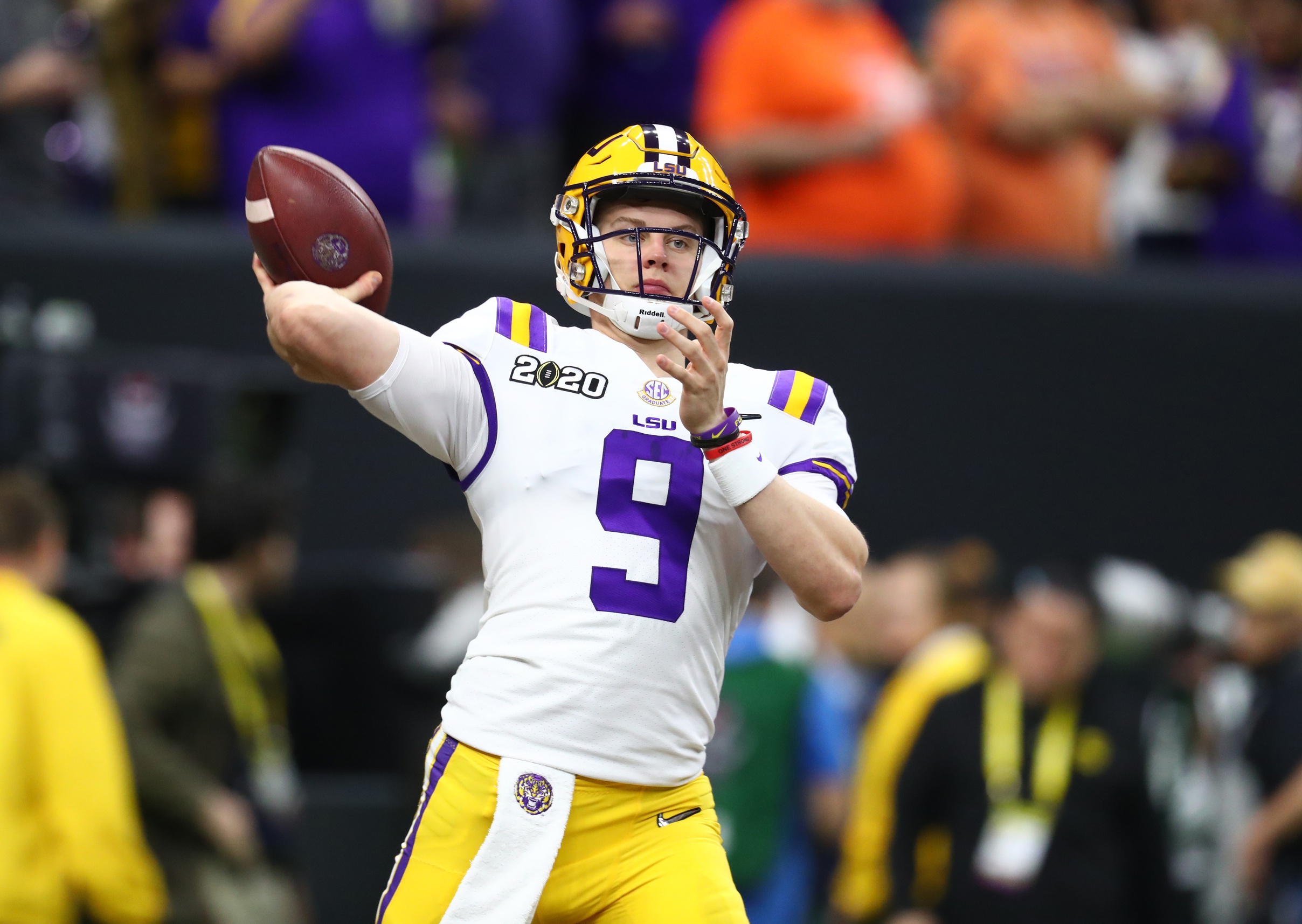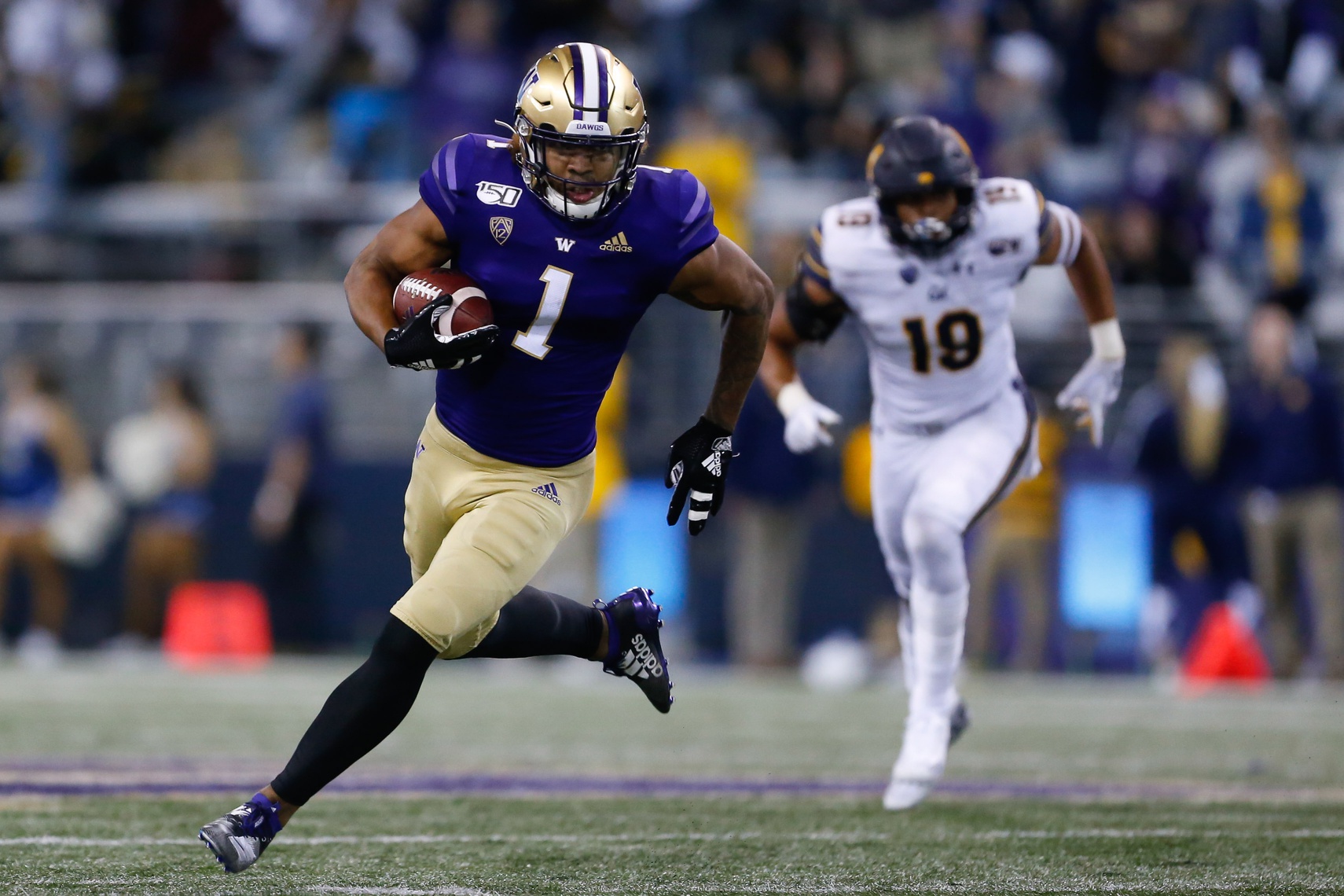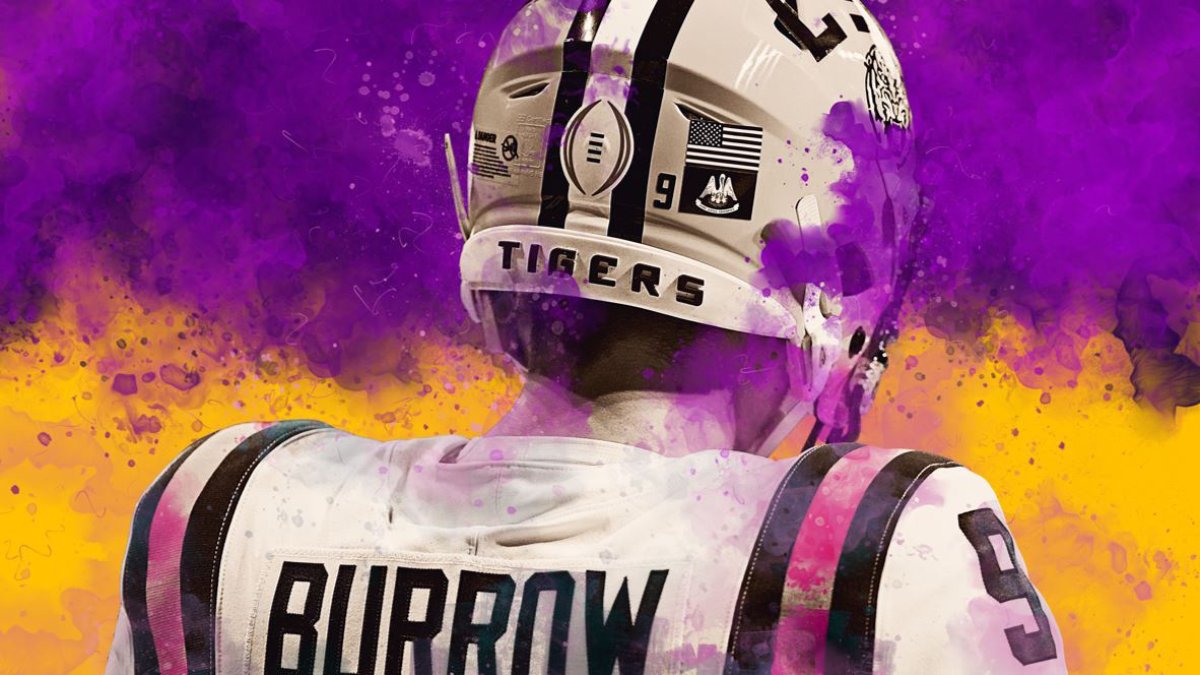With more than a decade of NFL play-by-play data and six years of FBS data, the PFF database has a plethora of information to project college players to the NFL. The PFF grade is a unique, production-based assessment of each player’s performance on every snap, and it is the foundation for our projection system. While the grade itself is valuable when standing on its own, it’s the construction of the grade and the surrounding context that adds the most predictive power. Each position has its own set of metrics that are more important when projecting college players to the next level, and each position has its own strengths and weaknesses when it comes to using data for projections.
Here's a position-by-position look at the most stable and unstable measures of play for each position group and the key stats that are critical when projecting this draft class to the NFL.
[Editor's note: Check out all of PFF's 2020 NFL Mock Drafts and NFL Draft Big Board. PFF Elite subscribers can also download the 1,100-page 2020 NFL Draft Guide.]
Quarterback
Stable Metrics:
-
- Passing grade from a clean pocket
- Passing grade on standard dropbacks (from within the pocket)
- Passing grade on first/second down
- Passing grade with no play action
- Passing grade on passes at/beyond the sticks
- Percentage of negatively graded throws
Unstable Metrics:
-
- Passing grade under pressure
- Passing grade from outside the pocket
- Passing grade on third/fourth down
- Passing grade with play action
- Percentage of positively graded throws
Draft Class Notes
-
- When compared to quarterbacks who have played significant time in both college and the NFL since 2014, Joe Burrow ranks above the 72nd percentile in every stable metric and he’s in at least the 90th percentile in passing grade from a clean pocket, passing grade on first/second down and avoiding negatively graded throws. This includes both his 2018 and 2019 seasons.
- Alabama’s Tua Tagovailoa ranks in at least the 74th percentile when compared to the same group above, and he has only one grade in the 90th percentile (passing grade from clean pocket).
- Oregon’s Justin Herbert ranks just 34th out of 39 qualifiers (quarterbacks with significant college and NFL snaps since 2014) at avoiding negatively graded throws over the past two seasons.

Running Back
Stable Metrics:
-
- Rushing grade
- MT/ATT (missed tackles per attempt)
- YCo/ATT (yards after contact per attempt)
- Receiving grade
- MT/Reception (missed tackles per reception)
- Yards per route run
Unstable Metrics:
-
- Yards before contact/Rush
- Fumble%
- Breakaway%
- Team run-blocking grade (when player is the runner)
- Drop%
Draft Class Notes:
-
- Only two Power-5 running backs finished in the top 10 in both missed tackles per attempt and missed tackles per reception: Utah’s Zack Moss and Miami’s Deejay Dallas.
- Moss is the only running back to finish in the top six of all six stable metrics, including a No. 1 ranking in yards per route run (2.37).
- LSU’s Clyde Edwards-Helaire finished sixth in the class with 0.33 missed tackles per carry, but he also had the seventh-highest yards before contact figure at 3.01 per carry. He was excellent at making defenders miss, but he benefited greatly from his supporting cast at LSU.
- Last season, Georgia’s D’Andre Swift ranked just 49th in missed tackles per attempt as a runner (0.20) and 73rd in missed tackles/reception (0.16) — both potential concerns for the next level.
Wide Receiver
Stable Metrics:
-
- Receiving grade
- Receiving grade vs. single coverage
- Receiving grade vs. ZUT (zone, underneath, top)
- Separation% (all targets):
- Separation% vs. single coverage
- Yards per route run
- aDOT
- YAC/Rec
Unstable Metrics:
-
- Drop rate
- Contested catch%
- Catchable targets
Draft Class Notes:
-
- Only three wide receivers averaged more than 12.0 yards/target when targeted in single coverage last season: LSU’s Justin Jefferson, USC’s Michael Pittman Jr. and Minnesota’s Tyler Johnson
- Jefferson caught a ridiculous 92% of his contested catch opportunities (12-for-13), a rate that is unstable and unsustainable at the next level.
- Over the last two seasons, only three wide receivers have an average depth of target of at least 10.0 yards and YAC/reception of at least 9.0: Alabama’s Henry Ruggs III, Oklahoma’s CeeDee Lamb and Arizona State’s Brandon Aiyuk.
Tight End
Stable Metrics:
-
- Receiving grade
- Receiving grade vs. single coverage:
- Receiving grade vs. ZUT (zone, underneath, top)
- Separation% (all targets):
- Separation% vs. single coverage
- Yards per route run
- aDOT
- YAC/Rec
- Run-blocking pos. grade %
Unstable Metrics:
-
- Drop rate
- Contested catch%
- Catchable targets
- Run-blocking neg. grade%
Draft Class Notes:
-
- Florida Atlantic’s Harrison Bryant has the highest receiving grade when targeted against single coverage over the past two years.
- Washington’s Hunter Bryant has the highest yards per route run in the class over the past two years at 2.77.
- Stanford’s Colby Parkinson has 23 contested catches over the past two years, nine more than any other tight end in the draft class.

Offensive Tackle
Stable Metrics:
-
- Pass-blocking grade
- Pass-blocking grade on true pass sets
- Pass-blocking grade with no play action
- Pass-blocking grade on 5, 7-step concepts
- Run blocking on gap runs
- Run blocking on zone runs
- Run blocking negatively graded play percentage
Unstable Metrics:
-
- Pass-blocking grade with play action
- Pass-blocking grade on 3-step concepts
- Pass-blocking grade vs. 3-man rush
- Sack% allowed
- Run blocking positively graded play percentage
Draft Class Notes:
-
- Houston’s Josh Jones had the lowest percentage of negatively graded blocks in the run game last season. He’s also the only tackle in the class to finish with a top-three run-blocking grade on both gap and zone runs.
- UConn’s Matt Peart had the fourth-best pass-blocking grade on true pass sets last season (86.7). His pass-blocking success, combined with his inexperience at the position, makes him an excellent candidate as a developmental tackle.
- There are four offensive tackles with first-round grades on the PFF draft board, and all four have ranked in the top 15 in the class in pass-blocking grade on true pass sets over the past two years (Tristan Wirfs, third; Andrew Thomas, seventh; Josh Jones, 11th; Jedrick Wills Jr., 15th)
Interior Offensive Line
Stable Metrics:
-
- Pass-blocking grade
- Pass-blocking grade on true pass sets
- Pass-blocking grade with no play action
- Pass-blocking grade on 5, 7-step concepts
- Run-blocking on gap runs
- Run-blocking on zone runs
- Run-blocking positively graded play percentage
Unstable Metrics:
-
- Pass-blocking grade with play action
- Pass-blocking grade on 3-step concepts
- Pass-blocking grade vs. 3-man rush
- Sack% allowed
- Run blocking negatively graded play percentage
Draft Class Notes:
-
- Wisconsin center Tyler Biadasz has the highest percentage of positively graded blocks in the run game over the past three years, as he’s proficient in every type of block. It’s his pedestrian 69.3 pass-blocking grade on true pass sets last season that is a concern for his projection.
- Michigan’s Ben Bredeson has the highest pass-blocking grade on true pass sets over the past two years (89.7). The concern is his work in the run game, where he ranks just 63rd in positively graded blocks during that time.
- Ohio State’s Jonah Jackson is the No. 2 guard on the PFF draft board after ranking fifth in pass-blocking grade on true pass sets over the past two years and 12th in positively graded block percentage in the run game.
[Editor's note: Check out all of PFF's 2020 NFL Mock Drafts and NFL Draft Big Board. PFF Elite subscribers can also download the 1,100-page 2020 NFL Draft Guide.]
EDGE
Stable Metrics:
-
- Pass-rushing grade
- Pass-rushing grade on true pass rushes
- Pass-rushing grade with no play action
- Pass-rushing win%
- Run-defense grade
- Run stop%
Unstable Metrics:
-
- Sack%
- Clean-up/Pursuit pressure%
Draft Class Notes:
-
- Ohio State’s Chase Young has the highest single-season pass-rushing grade (96.5) since 2014, as well as the top pass-rushing win rate (27.2%) among edges with at least 300 rushes.
- Michigan’s Josh Uche has the highest pass-rushing win percentage in the draft class over the last two years (27.1%).
- LSU’s K’Lavon Chaisson ranked just 41st in the draft class in pass-rushing grade (78.9) and 67th in win rate (14.1%). Both numbers are concerns for the expected first-rounder.

DEFENSIVE INTERIOR
Stable Metrics:
-
- Pass-rushing grade
- Pass-rushing grade on true pass rushes
- Pass-rushing grade with no play action
- Pass-rushing win%
- Run-defense grade
- Run stop%
Unstable Metrics:
-
- Sack%
- Clean-up/Pursuit pressure%
Draft Class Notes:
-
- The only interior defensive lineman in the draft class to rank in the top five in both pass-rushing grade and run-defense grade last season is Missouri’s Jordan Elliott (first in pass rush, fourth in run defense)
- One of the reasons South Carolina’s Javon Kinlaw has moved above Auburn’s Derrick Brown on the final PFF draft board is Kinlaw’s two-year pass rush win rate (15.4%), which ranks first in the class. Brown comes in at 14.3%, good for 11th.
- Baylor’s Bravvion Roy is a mid-rounder to watch. The 330-pounder finished with the No. 7 pass-rushing grade (83.7), No. 20 grade against the run (85.6) and the No. 7 run-stop percentage (10.2%) in the class last season.
LINEBACKER
Stable Metrics:
-
- Coverage grade
- Coverage grade in the box
- Coverage grade in the slot
- Forced incompletion percentage
- Run-defense grade
- Run stop%
- Pass-rushing grade
Unstable Metrics:
-
- Coverage grade with pressure
- Coverage grade on passes >3.0 seconds
- Coverage grade in single coverage
- Coverage grade in ZUT (zone, underneath, top)
- Passer rating against
- Missed tackle rate
Draft Class Notes:
-
- Other than Clemson’s Isaiah Simmons, the only linebackers to rank in the top 10 in the class in both coverage grade and run-defense grade over the past two years are Utah State’s David Woodward, Wyoming’s Logan Wilson and Missouri’s Cale Garrett
- Last season, Wilson ranked fourth both in coverage grade with no pressure (83.6) and in coverage grade from the slot (79.5).
- Michigan State’s Joe Bachie has the highest grade in the class against the run over the past two years (91.8), but he ranks just 34th with a coverage grade of 79.3.
Cornerback
Stable Metrics:
-
- Coverage grade
- Coverage grade with no pressure
- Coverage grade on passes <=3.0 seconds
- Coverage grade in single coverage
- Coverage grade at outside CB
- Coverage grade in the slot
- Forced incompletion percentage
Unstable Metrics:
-
- Coverage grade with pressure
- Coverage grade on passes >3.0 seconds
- Coverage grade in ZUT (zone, underneath, top)
- Passer rating against
Draft Class Notes:
-
- Louisiana Tech cornerback Amik Robertson had the No. 1 coverage grade in the class in single coverage last season (92.7), and he also has the top grade in the slot (93.6),
- Among corners with at least 50 targets over the past two years, Virginia’s Bryce Hall has the highest percentage of forced incompletions (31.5%).
- LSU’s Kristian Fulton has the highest percentage of forced incompletions of any cornerback from 2017-19 (29.1%).
- Clemson’s A.J. Terrell has been targeted 27 times over the past two years when the quarterback has been under pressure — most in the draft class.
Safety
Stable Metrics:
-
- Coverage grade
- Coverage grade with no pressure
- Coverage grade on passes <=3.0 seconds
- Coverage grade at safety
- Coverage grade at free safety
- Coverage grade in the slot
- Coverage grade in the box
- Forced incompletion percentage
- Run-defense grade
- Run stop%
Unstable Metrics:
-
- Coverage grade with pressure
- Coverage grade on passes >3.0 seconds
- Coverage grade in single coverage
- Coverage grade in ZUT (zone, underneath, top)
- Passer rating against
- Missed tackle rate
Draft Class Notes:
-
- Projecting players into the same coverage role is critical, and Clemson’s Isaiah Simmons has performed well in every projected role. Over the past two years, he has a 90.2 coverage grade when lined up in the box, an 88.4 grade at safety and an 80.2 grade when lined up in the slot. All three numbers rank in the top 11 in the draft class among all safeties and linebackers.
- Utah safety Terrell Burgess had the No. 2 coverage grade in the slot (82.4) and the No. 4 mark while playing in the box (87.0) in the draft class last season.
- Iowa’s Geno Stone has the highest coverage grade in the class among Power-5 safeties over the past two years (91.3).



 © 2025 PFF - all rights reserved.
© 2025 PFF - all rights reserved.